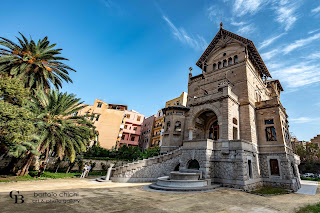La caduta di Icaro sulla terra della Valle dei Templi - The fall of Icarus on the land of the Valley of the Temples di Giorgia Görner Enrile
La caduta di Icaro sulla terra
della Valle dei Templi
The fall of Icarus on the land
of the Valley of the Temples
di
Giorgia Görner Enrile
“Io prego te, lieta di feste, splendida fra le città degli uomini, dimora di Persefone, che stai, lungo le sponde dell’Akragas, ricco di greggi, sopra il colle solido”, così Pindaro descrive l’antica polis in cui si estende la Valle dei Templi.
“I pray to you, happy at parties, splendid among the cities of men, home of Persephone, who are on the banks of the Akragas, rich in flocks, on top of the solid hill”, so Pindar describes the ancient polis where extends the Valley of the Temples.
Conquistata e distrutta dai Cartaginesi nel 406, nel corso dei secoli, l’area fu sotto il controllo romano, arabo e normanno. Questo a causa della sua posizione strategica che domina Porto Empedocle e lo Stretto di Sicilia, lungo una cresta rocciosa sotto l’odierna Agrigento, scelta come limite meridionale della città.
Quello che ne è rimasto è ora uno dei siti archeologici più vasti, rappresentativi e meglio conservati della Magna Grecia. Nel 1997 venne riconosciuto dall’UNESCO come Patrimonio dell’Umanità. Il suggestivo parco è costituito da otto templi inalzati tra il 510 a.C. e il 430 a.C. circa: il Tempio di Hera, il Tempio della Concordia, il Tempio di Eracle, il Tempio di Zeus Olimpio, il Tempio di Castore e Polluce, il Tempio di Efesto, il Tempio di Demetra e il Tempio di Asclepio.
Al suo interno son presenti anche altri vari resti e il Museo archeologico regionale Pietro Griffo ospita 5688 reperti che illustrano la storia del territorio dalla preistoria alla fine dell’età greco- romana.
Nella Valle dei templi, si trova anche il Giardino di Kolymbethra, situato tra il Tempio di Castore e Polluce e il Tempio di Vulcano. Dopo anni di abbandono, il Fondo Ambiente Italiano ha riportato il giardino alla suo antico splendore. Nei suoi cinque ettari vi è una meravigliosa varietà di flora tra cui: mirto, lentisco, terebinto, ginestra, salice e pioppi bianchi, antiche varietà di limoni, mandarini e aranci, cespugli di gelso, fichi d’india e carrubi, mandorle e ulivi secolari Saracena. Suggestiva anche la presenza della statua di Icaro con l’ala spezzata che si trova vicino al Tempio della Concordia. Icaro era il giovane figlio di Dedalo e Naucrate, una schiava del re Minosse. Dedalo, un giorno, costruì un labirinto per sfuggire al Minotauro rimanendo, però, con Icaro bloccati al suo interno.
Dedalo per scappare, costruì delle ali che attaccò con la cera alle spalle del figlio.
I due riuscirono a fuggire e fu la prima volta che l’uomo riuscì a combattere le leggi della natura e a battere la gravità. Sebbene fosse stato avvertito, Icaro, entusiasta di volare, preso dalla straordinaria sensazione di libertà, iniziò a salire, sempre più in alto, per salutare il sole, tuffarsi in basso verso il mare e poi di nuovo in alto ma, avvicinandosi al sole, la cera si squagliò ed Icaro precipitò in mare e annegò.
La statua è un’opera realizzata dall’artista Igor Mitoraj. Una moderna interpretazione dello stile classico donata dall’artista polacco nel 2011.
Conquered and destroyed by the Carthaginians in 406, over the centuries, the area was under Roman, Arab and Norman control. This is because of its strategic position overlooking Porto Empedocle and the Strait of Sicily, along a rocky ridge below today’s Agrigento, chosen as the southern limit of the city.
What remains of it is now one of the largest, most representative and best preserved archaeological sites in Magna Graecia. In 1997 it was recognized by UNESCO as a World Heritage Site. The suggestive park consists of eight temples built between 510 BC. and 430 BC about: the Temple of Hera, the Temple of Concordia, the Temple of Heracles, the Temple of Olympian Zeus, the Temple of Castor and Pollux, the Temple of Hephaestus, the Temple of Demeter and the Temple of Asclepius.
Inside there are also other ruins and the Pietro Griffo Regional Archaeological Museum houses 5688 exhibits illustrating the history of the area from prehistory to the end of the Greco-Roman age.
In the Valley of the temples, there is also the Garden of Kolymbethra, located between the Temple of Castor and Pollux and the Temple of Vulcan. After years of neglect, the Italian Environment Fund has restored the garden to its former glory. In its five hectares there is a wonderful variety of flora including: myrtle, mastic, terebinth, broom, willow and white poplars, ancient varieties of lemons, mandarins and oranges, mulberry bushes, prickly pears and carob trees, almonds and olive trees centuries-old Saracen. Also striking is the presence of the statue of Icarus with the broken wing located near the Temple of Concordia. Icarus was the young son of Daedalus and Naucrates, a slave of King Minos. Daedalus, one day, built a labyrinth to escape the Minotaur while remaining, however, with Icarus stuck inside. To escape, Daedalus built wings which he attached with wax to his son’s shoulders.
The two managed to escape and it was the first time that man managed to fight the laws of nature and beat gravity. Although he had been warned, Icaro, enthusiastic about flying, taken by the extraordinary sensation of freedom, began to rise, higher and higher, to greet the sun, dive down to the sea and then up again but, approaching the sun, the wax melted and Icarus fell into the sea and drowning. The statue is a work created by the artist Igor Mitoraj. A modern interpretation of the classic style donated by the Polish artist in 2011.
Se volete leggere l'intero articolo, potete scaricare GRATUITAMENTE il secondo numero della nostra rivista "Sicily in Photo Magazine" al seguente link:
http://www.mediafire.com/file/uzwnqmyp25p2nwl/file




Commenti
Posta un commento